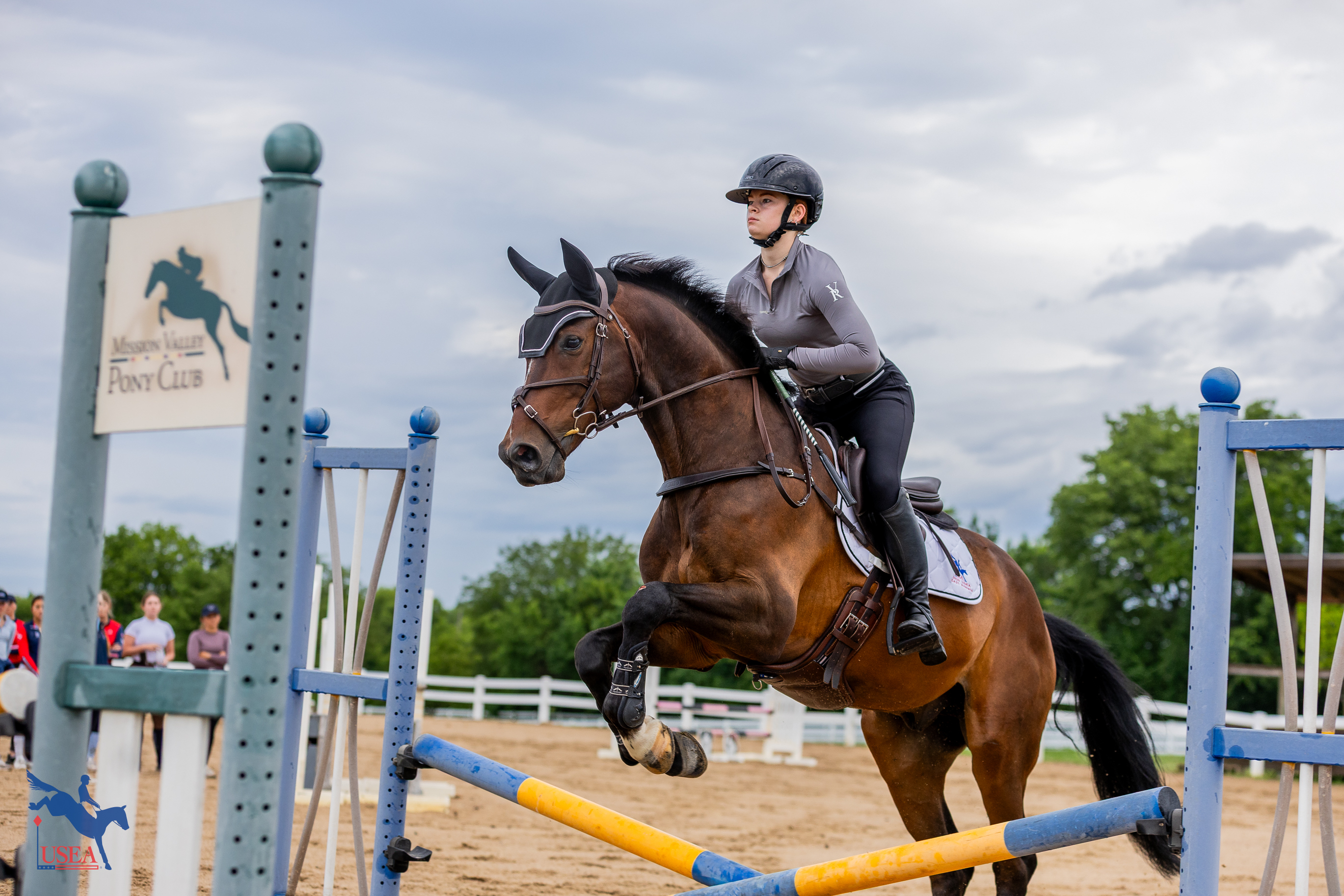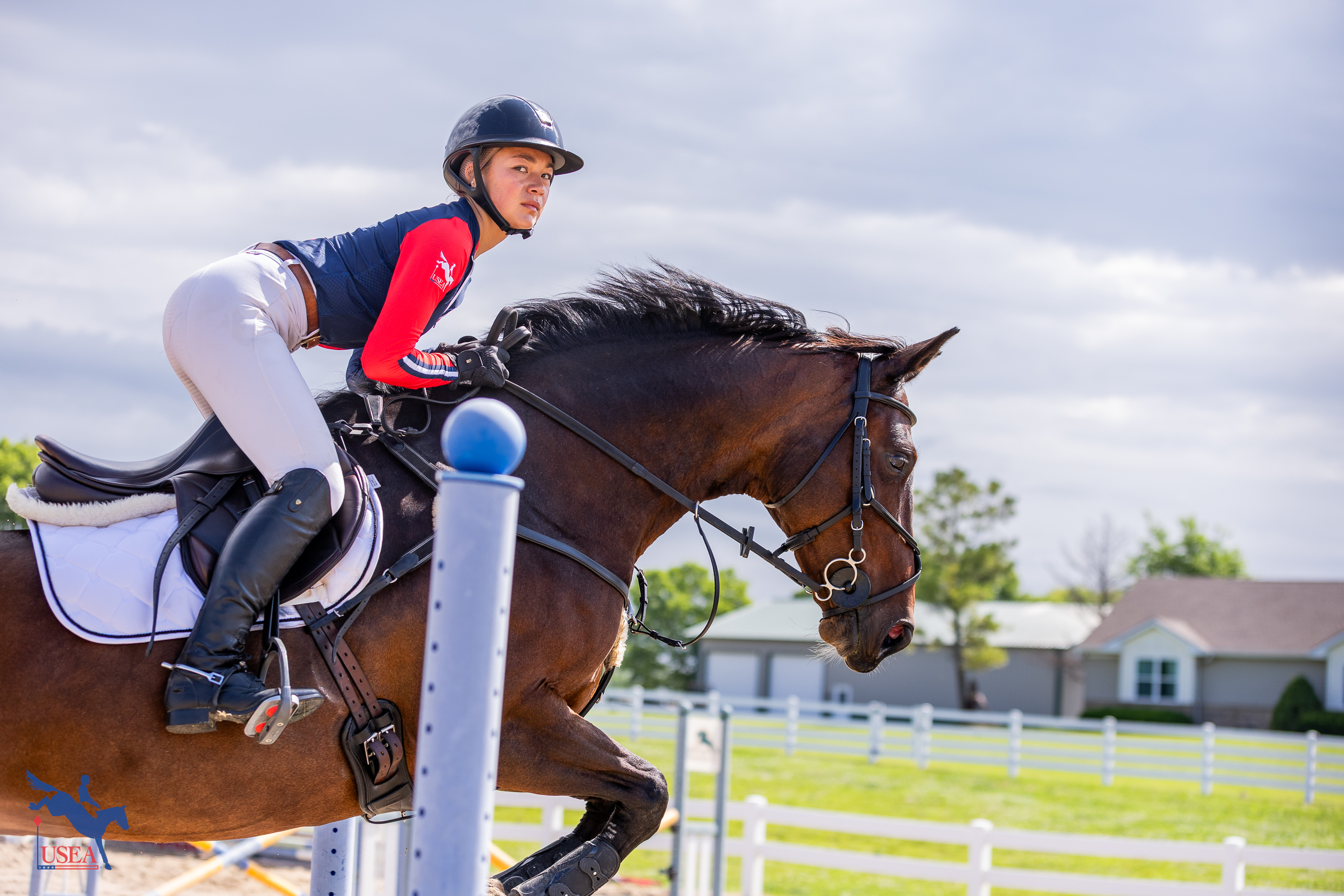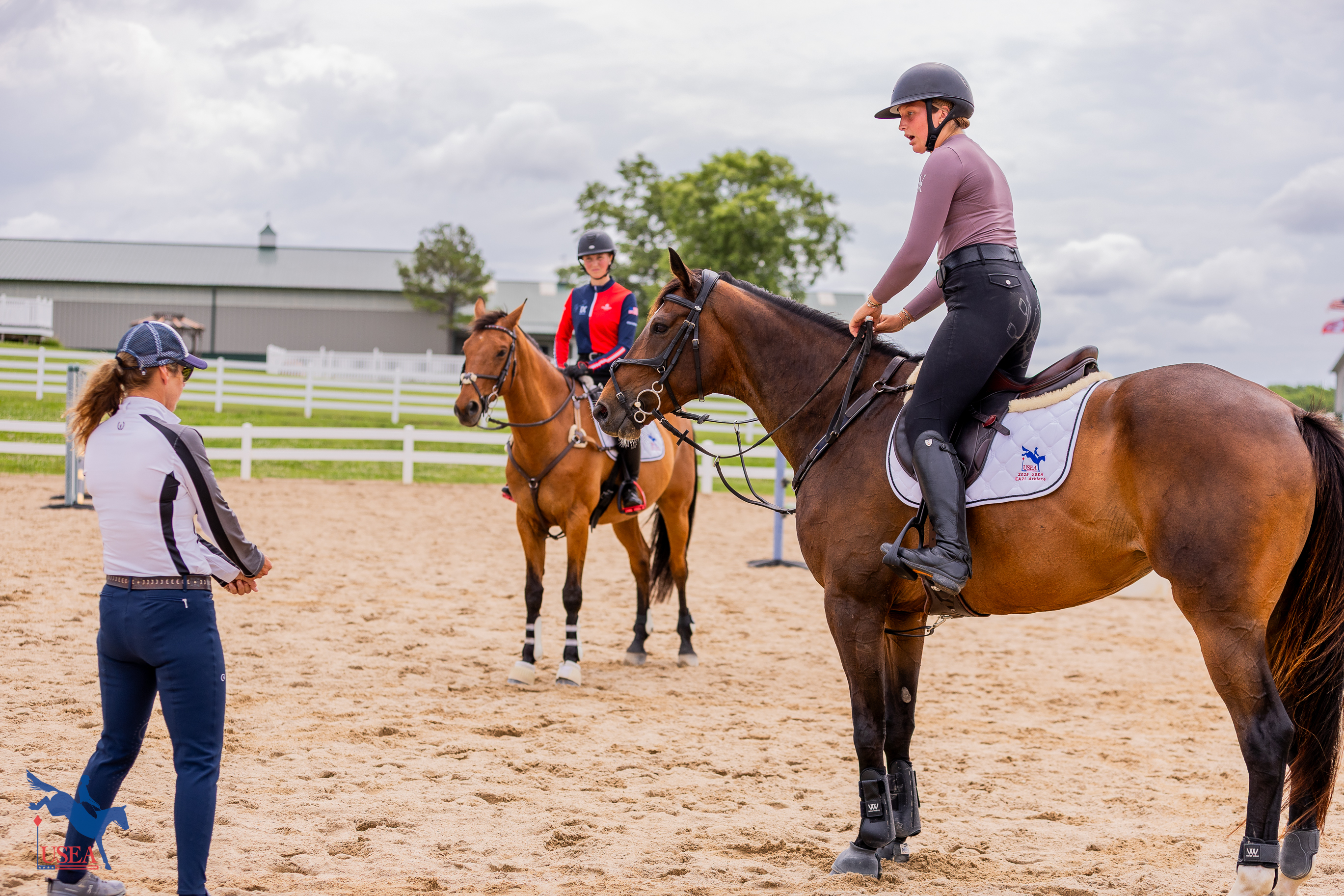Elasticity Through the Elbows: Finding the Balance on Day 2 of the USEA EA21 Central Clinic

Bucyrus, Kan. – June 18 – “Transformation” was the theme of the week at the USEA Emerging Athletes U21 Program (EA21) Central Clinic at Chaps Equestrian Center. Twelve talented young riders arrived on Monday to learn from coach Shannon Lilley, and they didn’t waste a minute of the experience. From the multi-hour lectures to the focused time spent in the saddle, the participants took on every challenge with gusto and left Lilley stunned by their progress.
“They were all fantastic,” Lilley exclaimed. “I didn’t know what to expect, but this is the same exercise I did [at Morven Park in Virginia] last year, and these kids were quite good. This hopefully gives them the right fundamentals, because a lot of them made some serious changes. Then the horses got better, because they got better.”
Building on the lessons learned on the flat yesterday, Lilley created a progressive plan over the fences that encouraged riders to “create their toolbox” before being sent out for the course work. Yet again, the riders’ position and biomechanics played a strong role in the changes and successes gleaned from each lesson.
Unlike the dressage lessons, which had significant tailoring of exercises based on the skill level and needs of the horses and riders in the ring, the jumping exercises remained generally consistent throughout the day. Four groups of three horse and rider pairs were each given one and a half hours of dedicated time with Lilley to workshop their show jumping, and even some cross-country, techniques.
Lilley separated the warm-up into three basic exercises that were meant to help the riders establish a baseline for the connection with their horses and determine the balance of their canter to rely on throughout the remainder of the lesson. After warming up independently on the flat, Lilley asked the riders to circle half of the arena and add one vertical fence set on the short end of the ring to their path. This exercise allowed them to establish an appropriate medium canter and encouraged the horses to relax in the job at hand.
Next, Lilley introduced the first footwork exercise by incorporating a bounce, halt, and turn on the forehand into the mix. The riders would approach the same vertical from the first exercise at the canter, ride a bending line to the bounce, then halt, complete a half turn on the forehand to face back towards the bounce, and repeat the pattern in reverse, so they finished on over the vertical again.
The bounce itself, which was two small cross rails set at a 12' stride, was used to help the horses create shape in their canter, and subsequently, shape in their jump, while the halt, turn on the forehand, and bending line taught the riders to balance up through the changes in pace.

“The transitions, just like on the flat, end up bringing the shape forward and created the canter and the balance within the canter,” Lilley explained as she set up the second exercise for the group. “All the while, by doing transitions, we maintain rhythm, which creates balance. It should look seamless, but it’s not. You’re doing so many things, but it should look like one canter, and it doesn’t if you lose your canter and fall out of balance.”
Finally, once these prerequisites were met, Lilley had the riders use the outside line, which was set as a vertical to a square oxer on a forward, six-stride pace, to experiment with their horse’s adjustability. The riders approached the line one at a time and consecutively jumped it in a flowing six strides, then packaged their horses to fit seven strides between the jumps, and finished by traveling forward to get down the line in five strides. The exercise gave the riders a chance to manipulate their horses’ step by going back to the basics of their biomechanics to channel the movement in their seat and use an elastic connection through their elbows to achieve the number of strides they were directed to fit.
“Hopefully, by the end of the warm-up, they had these tools, and they recognize how, when, and where to use them in the course work,” said Lilley as she regrouped with each lesson before moving onto the first course. “It is set up by design that if they do those well, the courses should come easily. The lesson is meant to build, so everyone is successful, and in the end, they were!”
The courses that Lilley designed incorporated the basics from the warm-up exercises, and then took it one step further by adding several bending lines, more advanced fences, like a triple bar and a corner, and combinations of varied lengths. Lilley emphasized that, “in the jumping [exercises], as long as they go through the motions and maintain the balance, then it will work out the same for everybody.”
Two riders that stood out in their ability to take feedback and make visible changes in their riding were Ella Munsat and Sierra Fishell. As with the flatwork on day 1, Munsat started the day struggling to create enough impulsion from within and keep her hands in front of her eyes, which in turn caused her horse to be limited in her range of motion through her shoulders.
“I’ve always been a quieter rider, even in the dressage; I need more power, so when I first got out there, I was a bit out of my comfort zone,” Munsat recounted. The impact of her tendency towards backwards riding was more pronounced over the fences, as her horse struggled to find her balance and jumped over her shoulder, creating an awkward shape in the air.

By reintroducing a bridged rein, Lilley encouraged Munsat to use her hands as one unit, therefore narrowing the communication from horse to rider and making her aids clearer. Bridging the reins also forced Munsat to rely more heavily on her legs to act not only as a source of impulsion, but also as the main aid for steering.
“As soon as her hands went in front of her eyes and her elbow could work,” Lilley reflected, “the whole balance of the horse was completely different, and she never jumped over her shoulder again!”
The adjustability exercise during warmup was especially helpful for Munsat, as it allowed her to test the limits of her aids under Lilley’s watchful eye. By narrowing her focus on the step between the two fences, Munsat was able to fit anywhere from five to eight strides between the jumps, and in turn, could keep all four of those canter paces in her arsenal for when she switched to the course work.
“Shannon telling me where I needed to be and that it wasn’t too much [power] helped me really commit to it and not be afraid to mess up, because I am here to learn,” Munsat concluded. “It’s just putting the pieces together, because it’s all there. I feel like I got so much out of my lesson, and I can also take it home and better both of us.”
On the other hand, Fishell’s catch-ride, “Curly,” started the lesson with a lot of tension and exuberance that inhibited her ability to communicate with him effectively. Fishell quickly realized that Curly wasn’t fond of a deep seat, so she tested posting the canter to encourage relaxation.
Working off this change in position, Lilley encouraged Fishell to ride in more of an open seat and connect for the downward transitions by standing up taller in the saddle and opening her chest to ask for the half halt.

“I found that whenever she told me to really sit up and out of the saddle, it clicked,” Fishell noted. “Thoroughbreds, they don’t want you on their back, because if you think about how they’re ridden at the track, the jocks are off their back, so that was definitely a lightbulb moment. I have a few Thoroughbreds at home, and my instinct is to want to sit on them to balance, but I definitely found that this made it click thinking about how they were brought up.”
Lilley went on to explain that Thoroughbreds, by nature, need more step than one may think to relax in the body. By adjusting her position and opening the horse's canter, “the horse went from looking slightly unrideable when she first got on, to a point at the end where I was thinking ‘I would take him home. She should buy him!’ It was such a totally different ride by the end,” Lilley exclaimed. “It was all about using the hip out of the saddle, because she couldn’t sit or he’d go faster, so to find another way to use the hip was critical.”
Fishell, a three-year veteran of the EA21 Central Clinic, went on to credit Lilley’s coaching style for making it attainable to adjust her riding so drastically in the span of a lesson. “[East Coast I coach Bec Braitling and] Shannon are very similar in the way they coach. They’re both very approachable, and they almost speak your own language,” she explained. “The first year was a little bit humbling, but I just love the platform of the EA21 program. It’s just so structured and the coaching is so much more in depth.”
After more than five hours of teaching, Lilley had one message that remained true throughout: “They just need to get confident and learn to trust. Once they make their positional changes, they’re balanced on top of their horse, and then they’re effective from their seat and their leg. The idea of using your body to change the horse and turn the horses more is exactly what we’ve been going for.”
Two days of education culminated in one final shared meal and a dialogue on rider responsibility. Lilley’s imparting speech for the group focused on their duty to be stewards of the sport and represent it in a positive light. While social media is a fantastic tool to share the highlights of eventing, she cautioned the kids to reflect on the purpose and message that their content portrays anytime they share. She urged them to consult their non-riding friends or family members to ensure the pictures and videos they share are guided by a single focus: the love for the horse.
As a parting thought, Lilley shared her contact information with the riders and told them that her door is always open for continued dialogue and advice. Networking is one of the most fundamental keys for finding long-term success in the sport, so Lilley also emphasized the importance of volunteering. Not only is it a great way to expand their knowledge, but volunteering at local events gives the riders an opportunity to get to know other members in their Area, and make sure their event organizers, officials, and fellow competitors know them, too.
The USEA would like to share an immense thanks to Julie Wolfert for welcoming the EA21 athletes to her farm, Chaps Equestrian Center, and Christy Hagan for volunteering her time to coordinate this year’s Central Clinic. Without Julie and Christy’s selfless contributions to the program, this clinic would not have been possible. Thanks are in order for Shannon Lilley as well for imparting her extensive knowledge to the next generation of eventers through her infectious positivity.
The Participants
- Ava Davis
- Sierra Fishell
- Carter Jackson
- Ella Munsat
- Finley Powell
- Shaena Putnam
- Willow Schwartz
- Sophia Street
- Mia Volpentesta
- Elle White
- Brett Youssi
Follow along with the USEA coverage on social media!
Facebook | Instagram | Threads | TikTok
About the USEA Emerging Athlete U21 Program (EA21)
The purpose of the USEA Emerging Athletes U21 Program (EA21) is to identify and provide consistent quality instruction to the next generation of elite event riders. The aim is to create a pipeline for potential team riders by identifying and developing young talent, improving horsemanship and riding skills, and training and improving skills and consistency.
The USEA Emerging Athletes U21 Program was launched in 2022 with a model of five summertime regional clinics taught by carefully selected USEA Eventing Coaches Program (ECP) coaches, leading to a winter national camp consisting of selected Young Riders from the regional clinics. Athletes who are 21 years or younger, are current members of their USEA Young Rider Area program, and are established at the Training Level or higher, are eligible to apply for the EA21 program. Click here to learn more about the USEA EA21 Program.
The USEA would like to thank ARMA, Bates Saddles, Horse Illustrated, Kerrits, PulseVet, Ride iQ, Schneiders Saddlery, Sidelines Magazine, WeRideTogether, and YETI for sponsoring the USEA Emerging Athletes U21 Program.


























